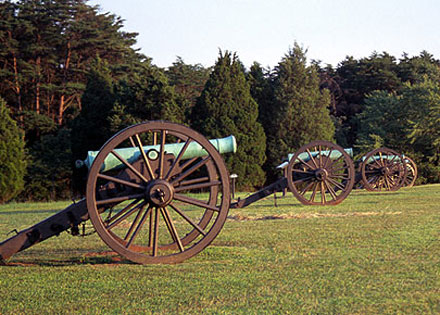Barely half an hour from Washington, D.C., you’ll find the site of the first major battle of the Civil War — and the site of the Confederacy’s greatest victory.
In April 1861 the South fired the first shots of the war, taking Fort Sumter in Charleston Harbor, S.C. President Abraham Lincoln hastily raised an army of volunteers and sent them to march on Richmond, hoping to capture the Confederacy’s new capital city and end the war quickly. Congressmen and other onlookers followed with picnic baskets to watch the show. The first stop was the railroad junction at Manassas, a key point of control leading to the Shenandoah Valley.
But the inexperienced volunteers were turned back. In all more than 4,000 men died, as it became clear that the war would be far longer, and bloodier, than anyone had dreamed.
A year later the Confederate and Union armies again fought at Manassas, and again the Union army was turned back. This time the fighting lasted three days, and nearly 25,000 men died. The Union was dealt such a sharp defeat that the South actually pressed on into Maryland, only to be stopped themselves two weeks later at Antietam.
Today this historic site is preserved as Manassas National Battlefield Park. The museum on site displays Civil War era uniforms, weapons, and field gear, and includes an electronic map that allows visitors to understand the strategy and tactics used by both sides. You can walk the battlefield on a self-guided tour or take a tour led by park rangers to see Matthew’s Hill, where Union troops drove the Confederates backward in the First Battle, and Henry Hill, where Stonewall Jackson rallied the Confederates and earned his nickname.
You’ll also see Brawner Farm, site of the first skirmish of the Second Battle, Deep Cut, where Union troops attacked Southern lines again and again without success, and Chinn Ridge, where Union troops desperately held off the Confederate counterattack as the bulk of the Northern army fled.
Travel Tips
Five separate ranger-led tours of either 45 minutes or 1 hour each cover different aspects of the First and Second Battles of Manassas. Four of them are offered only once a day, so check the schedule to figure out which one or several interest you. If you visit in mid-July or late August, you might want to time your trip to coincide with the park’s annual battle anniversary weekends, which include living history encampments showing how soldiers lived, along with artillery and musket firing demonstrations.
For more information, visit www.nps.gov/mana.
Travel InformationManassas National Battlefield Park Hours: The park is open daily from dawn to dusk. The Henry Hill Visitor Center is open daily from 8:30 a.m. to 5 p.m., except on Thanksgiving and Christmas days. The historic Stone House is open from 10 a.m. to 4:30 p.m. daily. Admission: Free, donations are accepted. For additional fee information, click here. Parking: West on I-66 to Route 234 North. The entrance to the park and its parking lot is on the right. Metrorail: N/A |
Nearby Attractions
Udvar-Hazy Museum
Shenandoah National Park

Leave a Reply